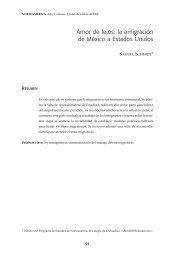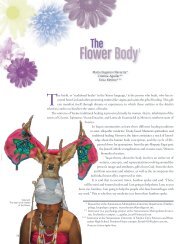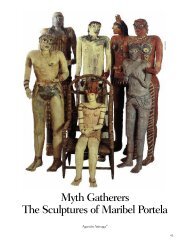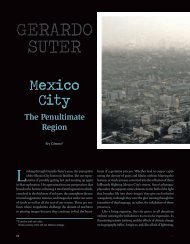Sun and Shadows in Modern Mexican Photography Manuel
Sun and Shadows in Modern Mexican Photography Manuel
Sun and Shadows in Modern Mexican Photography Manuel
Create successful ePaper yourself
Turn your PDF publications into a flip-book with our unique Google optimized e-Paper software.
The exhibition “<strong>Sun</strong> <strong>and</strong> <strong>Shadows</strong> <strong>in</strong> <strong>Modern</strong> <strong>Mexican</strong><br />
<strong>Photography</strong>. <strong>Manuel</strong> Álvarez Bravo, Agustín<br />
Jiménez, <strong>and</strong> Luis Márquez” at the Old San Ildefonso<br />
College sought to construct a visual discourse that would<br />
56<br />
Agustín Jiménez Esp<strong>in</strong>osa, Recl<strong>in</strong><strong>in</strong>g Female Nude with Sphere, ca. 1920 (silver on gelat<strong>in</strong>).<br />
<strong>Sun</strong> <strong>and</strong> ShadowS<br />
<strong>in</strong> <strong>Modern</strong> <strong>Mexican</strong><br />
PhotograPhy<br />
<strong>Manuel</strong> Álvarez Bravo,<br />
Agustín Jiménez, <strong>and</strong> Luis Márquez<br />
*Academic at the unam Institute for Aesthetic Research.<br />
Photos by <strong>Manuel</strong> Álvarez Bravo courtesy of the <strong>Manuel</strong> Álvarez Bravo Archives, photos<br />
by Agustín Jiménez Esp<strong>in</strong>oza courtesy of the Agustín Jiménez Archives, <strong>and</strong> photos<br />
by Luis Márquez Romay courtesy of the unam’s Institute for Aesthetics Research.<br />
Ernesto Peñaloza Méndez*<br />
prompt reflection about the mean<strong>in</strong>g of our photographic avant<br />
garde <strong>and</strong>, <strong>in</strong> a way, br<strong>in</strong>g two outst<strong>and</strong><strong>in</strong>g photographers who<br />
were worldrenowned <strong>Manuel</strong> Álvarez Bravo’s contemporaries<br />
out of his shadow.<br />
Álvarez Bravo was undoubtedly the sun of a generation<br />
of photographers who radically renewed creative work. His<br />
quality, consistency, <strong>and</strong> particular style brought him great<br />
prestige nationally <strong>and</strong> <strong>in</strong>ternationally while most of his contemporaries<br />
were gradually left <strong>in</strong> the shadows of oblivion.<br />
María Jiménez/ Archivo Fotográfico Agustín Jiménez
Luis Márquez Romay, Nude with Skull, 1932 (silver on gelat<strong>in</strong>).<br />
Álvarez Bravo was<br />
undoubtedly the sun<br />
of a generation of<br />
photographers who<br />
radically renewed<br />
creative work. His<br />
quality, consistency, <strong>and</strong><br />
particular style brought<br />
him great prestige<br />
nationally <strong>and</strong><br />
<strong>in</strong>ternationally.<br />
<strong>Manuel</strong> Álvarez Bravo, Good Reputation Sleep<strong>in</strong>g,<br />
1938-1939 (silver on gelat<strong>in</strong>).<br />
afmt/iie-unam<br />
57<br />
© Colette Urbajtel/Archivo <strong>Manuel</strong> Álvarez Bravo, SC
María Jiménez/ Archivo Fotográfico Agustín Jiménez<br />
Agustín Jiménez Esp<strong>in</strong>osa, untitled, from the “Tolteca” series, 1931 (silver on gelat<strong>in</strong>). Luis Márquez Romay, Stairway, Monument to the Revolution, 1936 (silver on gelat<strong>in</strong>).<br />
In the 1920s <strong>and</strong> 1930s, <strong>Mexican</strong> photography changed,<br />
as did other art forms like pa<strong>in</strong>t<strong>in</strong>g, sculpture, theater, c<strong>in</strong>ema,<br />
music, <strong>and</strong> literature, <strong>and</strong> was renewed by figures like<br />
<strong>Manuel</strong> <strong>and</strong> Lola Álvarez Bravo, Emilio Amero, Raúl Estrada<br />
Discua, Arturo González Ruiseco, Agustín Jiménez, Eugenia<br />
Aurora Latapí, Luis Márquez, <strong>and</strong> Jesús Torres Palomar.<br />
They used as a start<strong>in</strong>g po<strong>in</strong>t a tradition, <strong>and</strong> the subsequent<br />
break, <strong>and</strong> then were nourished <strong>and</strong> <strong>in</strong>fluenced by, as well<br />
as <strong>in</strong>fluenc<strong>in</strong>g the work of colleagues like Edward Weston,<br />
T<strong>in</strong>a Modotti, Sergei Eisenste<strong>in</strong>, Paul Str<strong>and</strong>, Henri Cartier<br />
Bresson, <strong>and</strong> so many other foreign photographers who came<br />
through Mexico at that time, attracted by the l<strong>and</strong>scape <strong>and</strong><br />
a propitious, renovat<strong>in</strong>g environment as tri de an ancestral, <strong>in</strong>digenous<br />
culture <strong>and</strong> the avant garde im pe tus of the art so <strong>in</strong><br />
vogue <strong>in</strong> Europe <strong>and</strong> the United States.<br />
58<br />
This period, when what we now call the “historic avant<br />
garde of <strong>Mexican</strong> photography” developed, is characterized<br />
by the <strong>in</strong>corporation of elements <strong>and</strong> objects <strong>in</strong>to the visual<br />
universe that had not <strong>in</strong>terested artists before, or by the re<strong>in</strong>terpretation<br />
of traditional genres <strong>in</strong> photography, like portraiture,<br />
l<strong>and</strong>scapes, architecture, popular phenotypes, social<br />
struggles, <strong>and</strong> daily life. Abstract compositions, defamiliarization,<br />
<strong>in</strong>terest <strong>in</strong> pure textures, reflections, shadows, <strong>and</strong> highlights,<br />
as well as the use of diagonals, distortions, repetitions,<br />
<strong>and</strong> vanish<strong>in</strong>g po<strong>in</strong>ts were also <strong>in</strong>corporated <strong>in</strong>to their discourse.<br />
This made many of the images elevate <strong>Mexican</strong> photography<br />
to the <strong>in</strong>ternational plane.<br />
<strong>Manuel</strong> Álvarez Bravo was the one who ma<strong>in</strong>ly conferr ed<br />
artistic prestige on our photography. But, <strong>in</strong> addition to him,<br />
as mentioned above, an entire generation contributed to the<br />
afmt/iie-unam
© Colette Urbajtel/Archivo <strong>Manuel</strong> Álvarez Bravo, SC<br />
<strong>Manuel</strong> Álvarez Bravo, Triptych Cement 2 (La Tolteca), ca. 1931 (silver on gelat<strong>in</strong>).<br />
“modernization” of Mexico’s art of the lens, though most of<br />
its members are not very well known except to specialists.<br />
Someth<strong>in</strong>g else that should be taken <strong>in</strong>to consideration<br />
is that this renovat<strong>in</strong>g movement had noteworthy precedents<br />
among certa<strong>in</strong> photographers who worked <strong>in</strong> Mexico <strong>in</strong> the<br />
early twentieth century, the authors of “experimental” images<br />
that prematurely ventured <strong>in</strong>to the sphere of the new<br />
photography. I am referr<strong>in</strong>g here, for example, to “Studies of<br />
Flowers” by C.B. Waite <strong>in</strong> 1907, <strong>and</strong> “Studies of Viol<strong>in</strong>” by Je <br />
sús Avitia <strong>in</strong> the same year. Isolated shots by the photographers<br />
of the Revolution, like Agustín Casasola, <strong>and</strong> some images<br />
from photographic studios identified with the pictorialist<br />
current, like Librado García Smarth or Antonio Garduño<br />
himself, could also be <strong>in</strong>cluded on this list. In addition to<br />
this “preavantgarde” precedent, even without a systematic<br />
MANUEL ÁLVAREz BRAVO<br />
The “historic avant garde<br />
of <strong>Mexican</strong> photography”<br />
is characterized by the<br />
<strong>in</strong>corporation of elements<br />
<strong>and</strong> objects <strong>in</strong>to the<br />
visual universe that had not<br />
<strong>in</strong>terested artists before,<br />
or by the re<strong>in</strong>terpretation<br />
of traditional genres<br />
<strong>in</strong> photography.<br />
study, we would have to add the work of amateur photographers<br />
like Juan Crisóstomo Méndez <strong>and</strong> his representations<br />
of the fragmented body, or the work of artists not identified as<br />
photographers, but who work ed fleet<strong>in</strong>gly with a camera with<br />
frankly modern results, like Roberto Turnbull, A. Toussa<strong>in</strong>t,<br />
or Frida Kahlo herself. Recently, some of the photographs<br />
by Lola Álvarez Bravo’s first students, like Guillerm<strong>in</strong>a Álvarez,<br />
Diva O. Foscade, Raúl Abarca, <strong>and</strong> Raúl Conde —this<br />
last a true revelation— have been brought to light that would<br />
also be <strong>in</strong>cluded <strong>in</strong> the l<strong>in</strong>e of modern photography.<br />
A great deal rema<strong>in</strong>s to be discovered about our avant<br />
garde photography. In that sense, “<strong>Sun</strong> <strong>and</strong> <strong>Shadows</strong> <strong>in</strong> <strong>Modern</strong><br />
<strong>Mexican</strong> <strong>Photography</strong>. <strong>Manuel</strong> Álvarez Bravo, Agustín Jiménez,<br />
<strong>and</strong> Luis Márquez” proposes a different approach to<br />
these k<strong>in</strong>ds of images.<br />
59
María Jiménez/ Archivo Fotográfico Agustín Jiménez<br />
Agustín Jiménez Esp<strong>in</strong>osa, Eisenste<strong>in</strong> with Sugar Skull, 1931 (silver on gelat<strong>in</strong>).<br />
60<br />
“The doma<strong>in</strong> of photography as an art<br />
is no different from that of poetry: the<br />
untouchable <strong>and</strong> the imag<strong>in</strong>ary. But<br />
revealed, <strong>and</strong>, <strong>in</strong> a phrase, filtered<br />
by what is seen.” Octavio Paz<br />
These three artists were selected because they had several<br />
overlaps <strong>and</strong> common <strong>in</strong>fluences, above all at the beg<strong>in</strong>n<strong>in</strong>g<br />
of their professional careers <strong>and</strong> dur<strong>in</strong>g the consolidation of<br />
their personal styles <strong>in</strong> the late 1920s <strong>and</strong> the first half of the<br />
1930s. All three worked for the M<strong>in</strong>istry of Public Education<br />
(sep) <strong>and</strong> published their images <strong>in</strong> the same publications,<br />
like <strong>Mexican</strong> Folkways, Revista de Revistas (Magaz<strong>in</strong>e<br />
of Magaz<strong>in</strong>es), Nuestro México (Our Mexico), Todo (Everyth<strong>in</strong>g),<br />
El Universal Ilustrado (Illustrated Universal), <strong>and</strong> Excélsior.<br />
They also came together <strong>in</strong> the collective show by<br />
sculptor Guillermo Toussa<strong>in</strong>t <strong>and</strong> 11 photographers <strong>in</strong> the<br />
<strong>Modern</strong> Art Gallery, held <strong>in</strong> the National Theater <strong>in</strong> 1929.<br />
Together with Emilio Amero, they exhibited at the Civic Aviation<br />
Field <strong>in</strong> a show organized by the sep’s F<strong>in</strong>e Arts Department<br />
<strong>in</strong> 1931. Two years later, the three produced the photos<br />
that illustrated the book Escuelas primarias de la Secretaría<br />
de Educación Pública (Primary Schools of the M<strong>in</strong>istry of Public<br />
Education). Another th<strong>in</strong>g they shared was their <strong>in</strong>terest<br />
<strong>in</strong> film, where they participated as stillmen.<br />
<strong>Manuel</strong> Álvarez Bravo, The Day of the Dead, ca. 1930 (silver on gelat<strong>in</strong>).<br />
© Colette Urbajtel/Archivo <strong>Manuel</strong> Álvarez Bravo, SC
All three photographers can be appreciated from two<br />
st<strong>and</strong>po<strong>in</strong>ts: one, from a figurative po<strong>in</strong>t of view, that would<br />
analyze the themes that concerned the pa<strong>in</strong>ters <strong>and</strong> artists<br />
of the time who were seek<strong>in</strong>g representations of everyth<strong>in</strong>g<br />
national <strong>and</strong> the national identity. In this sense, 11 brief thematic<br />
nuclei can be identified: thorns (with photographs of<br />
maguey plants), <strong>in</strong>digenous fiestas, crafts, religiosity, still lifes<br />
(compositions with jicamas by Álvarez Bravo <strong>and</strong> prickly pears<br />
by Jiménez), a carrousel, death, fem<strong>in</strong><strong>in</strong>e nudes, fishes, children,<br />
<strong>and</strong> work. The second, more experimental <strong>and</strong> abstract<br />
st<strong>and</strong>po<strong>in</strong>t is made up of other nuclei: tools, stairways, brewery<br />
fermentation tanks, reflections, the La Tolteca factory (a<br />
centerpiece <strong>in</strong> the show), <strong>and</strong>, lastly, exercises <strong>in</strong> shadows,<br />
curves, <strong>and</strong> diagonal l<strong>in</strong>es.<br />
The museography can be termed sober <strong>and</strong> effective,<br />
with the walls <strong>in</strong> light tones <strong>and</strong> a few counterpo<strong>in</strong>ts <strong>in</strong> green.<br />
The illum<strong>in</strong>ation was designed to be soft so as not to dam<br />
age the old pr<strong>in</strong>ts, although, of course, visibility is good. The<br />
exhibition beg<strong>in</strong>s with a phrase from the Spanish writer of<br />
the Golden Age, Baltasar Gracián, that Álvarez Bravo used <strong>in</strong><br />
his 1945 exhibition at the Association of <strong>Modern</strong> Art, organized<br />
by Fern<strong>and</strong>o Gamboa: “When the eyes see what they<br />
had never seen, the heart feels what it had never felt.” 1 Another<br />
phrase, this time by Octavio Paz, is also writ large: “The<br />
doma<strong>in</strong> of photography as an art is no different from that of<br />
poetry: the untouchable <strong>and</strong> the imag<strong>in</strong>ary. But revealed,<br />
<strong>and</strong>, <strong>in</strong> a phrase, filtered, by what is seen.” 2<br />
One <strong>in</strong>terest<strong>in</strong>g detail <strong>in</strong> this exhibition is that it <strong>in</strong>clu des<br />
two shots from an important photo contest held by the bimonthly<br />
magaz<strong>in</strong>e Tolteca <strong>in</strong> its August 20, 1931, issue, cosponsored<br />
by the daily newspaper Excélsior. <strong>Manuel</strong> Álvarez<br />
Bravo won first place, <strong>and</strong> Agustín Jiménez took home six<br />
prizes. The w<strong>in</strong>n<strong>in</strong>g photos were exhibited for 10 days <strong>in</strong> the<br />
LUIS MÁRQUEz ROMAy<br />
Luis Márquez Romay, Masks of the Dead, 1931 (silver on gelat<strong>in</strong>).<br />
afmt/iie-unam<br />
61
Civic Museum of the F<strong>in</strong>e Arts Palace, from December 5 to<br />
15 of that year.<br />
José Antonio Rodríguez expla<strong>in</strong>s the great importance of<br />
this for the history of <strong>Mexican</strong> photography:<br />
62<br />
The images with which these members of the avantgarde<br />
took the country by storm were <strong>in</strong>comprehensible for the majority<br />
of photographers of the time. To a great extent, because<br />
they were made up of other reason<strong>in</strong>gs. Among them are glimpses<br />
<strong>and</strong> traces of avantgarde currents like Russian constructivism,<br />
cubism, or the new objectivity, all <strong>in</strong>tertw<strong>in</strong>ed; a form of aesthetic<br />
assimilation <strong>in</strong>to the <strong>in</strong>dustrial age made possible by the<br />
María Jiménez/ Archivo Fotográfico Agustín Jiménez<br />
spaces of the La Tolteca factory, which the other makers of<br />
bucolic images who had exercised their craft better <strong>in</strong> studio<br />
portraits or <strong>in</strong> nationalistic pr<strong>in</strong>ts were very far from underst<strong>and</strong><strong>in</strong>g….For<br />
that reason, the result of the Tolteca [magaz<strong>in</strong>e]<br />
exhibition was the consequence <strong>and</strong> manifesto of modern<br />
times….In the end, with them, photography would pave new<br />
ways forward. 3<br />
Undoubtedly, the exhibition managed to establish a visual<br />
dialogue among the images of these three artists that<br />
show the treatment of common themes <strong>and</strong> co<strong>in</strong>cid<strong>in</strong>g forms<br />
as the aesthetic s<strong>in</strong>gularities that made them st<strong>and</strong> out <strong>in</strong><br />
AGUSTíN JIMéNEz ESPINOSA<br />
Agustín Jiménez Esp<strong>in</strong>osa, Heart of a Maguey, 1934 (silver on gelat<strong>in</strong>).<br />
Foreign photographers came through Mexico at that time,<br />
attracted by the l<strong>and</strong>scape <strong>and</strong> a propitious, renovat<strong>in</strong>g environment as tri de<br />
an ancestral, <strong>in</strong>digenous culture <strong>and</strong> the avant garde im pe tus<br />
of the art so <strong>in</strong> vogue <strong>in</strong> Europe <strong>and</strong> the United States.
<strong>Manuel</strong> Álvarez Bravo, untitled, Magueys series, n.d. (silver on gelat<strong>in</strong>).<br />
Mexico’s postrevolutionary culture. A first rendition of the<br />
exhibit was hosted by the Mexico Institute <strong>in</strong> Paris as part<br />
of the 2010 Month of <strong>Photography</strong>. In Mexico, the number of<br />
images was <strong>in</strong>creased, br<strong>in</strong>g<strong>in</strong>g the f<strong>in</strong>al total to 75 photographs,<br />
25 per artist, attempt<strong>in</strong>g to ensure the majority were<br />
v<strong>in</strong>tage pr<strong>in</strong>ts from the period.<br />
The works come from the follow<strong>in</strong>g collections: the Museum<br />
of <strong>Modern</strong> ArtNational F<strong>in</strong>e Arts Institute, the unam<br />
Institute for Aesthetic Research, the Agustín Jiménez Archive,<br />
the <strong>Manuel</strong> Álvarez Bravo Association, the W<strong>in</strong>dsor<br />
Gallery, <strong>and</strong> the Carlos Córdova <strong>and</strong> González Rendón family<br />
private collections.<br />
notes<br />
1 One of Cratylus’s l<strong>in</strong>es <strong>in</strong> “El criticón: primera parte,” by Baltasar Gracián,<br />
1651. [Editor’s Note.]<br />
2 “Prologue,” Instante y revelación (poems by Octavio Paz <strong>and</strong> photographs<br />
by <strong>Manuel</strong> Álvarez Bravo) (Mexico City: Fonapas, 1982), p. 212. [Editor’s<br />
Note.]<br />
3 José Antonio Rodríguez’s article, “Una moderna dialéctica. La vanguardia<br />
fotográfica mexicana, 19301950,” appeared <strong>in</strong> the Huesca-Imagen 2004 ca talogue,<br />
published for the annual photography festival formerly held <strong>in</strong> Hues ca,<br />
Spa<strong>in</strong>, <strong>and</strong> which <strong>in</strong> 2004 centered on Mexico.<br />
Luis Márquez Romay, La Valent<strong>in</strong>a, 1935 (silver on gelat<strong>in</strong>).<br />
© Colette Urbajtel/Archivo <strong>Manuel</strong> Álvarez Bravo, SC<br />
afmt/iie-unam<br />
63







